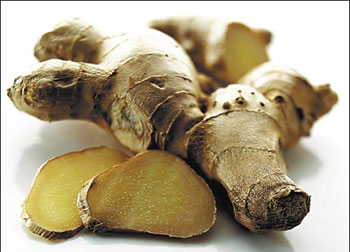Fred isn't the only partner for ginger
My first encounter with a finger of ginger (jiang) was around 10 years ago at university when my Pakistani housemate was whipping up a curry. At that time it was a distinctly alien ingredient, and I was baffled that this knobbly brown lump could be in any way related to the powdered stuff that gives ginger nuts and gingerbread men (reportedly "invented" by Queen Elizabeth I) their kick.
Of course, I am now fully aware of the superiority of fresh ginger in cooking, and since landing in China it has become my firm kitchen staple.

In Chinese cuisine, ginger is one of three essential base ingredients (alongside garlic and spring onions), usually used in its mature and familiar form - succulent flesh with a thin light brown skin. It is present in most stews, soups, stir-fries and dumplings but sometimes features more prominently and is especially favored with fish.
Qing zheng yu is a fantastic combination of river fish steamed with spring onions and ginger - very simple, clean and healthy. I love the combination of ginger with salmon; layer thin slices of ginger and garlic over the salmon steak, season with lemon and pepper, pour over a little white wine or fish sauce and enclose in a foil parcel. Bake for 15-20 minutes at 180 C.
For something more meaty try hong shao rou braised pork with soy sauce, sweetened heavily with overtones of ginger and star anise. A lively meatless option is the Shaanxi dish jiang zhi dou - gingered green beans.
Young ginger is less commonly seen - it has a pink tender skin and a pungent, spicy flavor. Sushi lovers will recognize it as a standard accompaniment in Japanese restaurants. In Hong Kong, young pickled ginger is typically served with duck's eggs as a starter dish to stimulate the appetite.
Ginger is brilliant in beverages - colleagues swear by the restorative properties of ginger boiled with water and brown sugar when they have a common cold.
My housemate has taken to boiling peeled ginger in water for a few hours, then using this concentrate mixed with three parts boiling water, a drop of honey and squeeze of lemon as a replacement for his morning cuppa.
It certainly gives you a wake-up buzz and may be a useful alternative for those looking to reduce their caffeine intake. Try mixing the same concentrate with a little sugar syrup and cold soda water to make your own ginger ale.
Ginger has several chemicals which may make it beneficial to health. The characteristic aroma and spiciness is due to gingerol, which, unsurprisingly, is related to capsaicin found in chili peppers. It is this constituent which is thought to be responsible for ginger's nausea-reducing properties.
Indeed as a dietitian I routinely recommend ginger in the form of tea, ginger ale or even ginger bread to patients suffering with morning sickness during pregnancy, and there are several clinical trials supporting its efficacy. This has the great advantage of avoiding medication, which is always preferable during pregnancy.
|
Ginger, a firm kitchen staple in China. Quanjing |
Some people suffering with nausea following an operation find ginger helpful but trials have shown it is not effective in relieving chemotherapy-related nausea.
Ginger is known to have sialogue action, meaning it encourages production of saliva. This makes it useful aid for singers who use it in the form of tea, or simply in its raw form to help them belt out clear high notes.
Curcumin is an anti-inflammatory in ginger, and a few studies have looked into its use for treating rheumatoid arthritis - mixed results so far, but this is an area for potential future research.
Finally, ginger is high in vitamin C and low in sodium, fat and calories, making it an excellent ingredient to liven up dishes which might otherwise be dowsed heavily with salt or sodium-heavy soy sauce, extra oil, butter or Mayonnaise.
This nutrition-related column is written by Nina Lenton, a qualified dietitian living and working in Beijing. Contact her at nina.lenton@ikang.com.
(China Daily 03/05/2008 page19)















